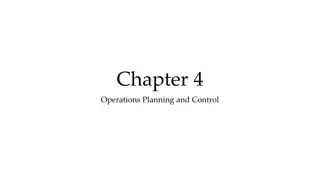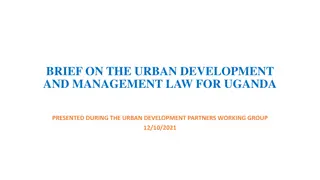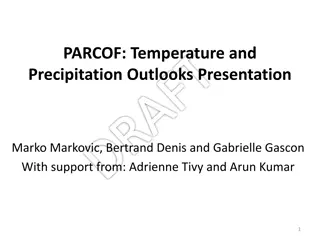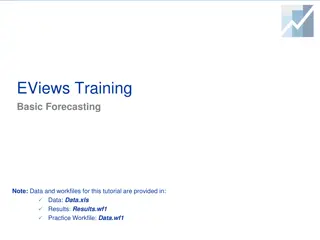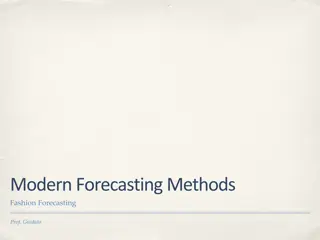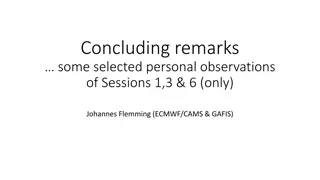Methods of Population Forecasting for Urban Development
Designing water supply and sanitation schemes for cities requires accurate population forecasting. Factors influencing population changes include births, deaths, migration, and annexation. Various methods like Arithmetic Increase, Geometric Increase, and Ratio Method are used to predict population growth for urban planning purposes. The Arithmetic Increase Method assumes constant population growth rate and is suitable for large cities.
Download Presentation

Please find below an Image/Link to download the presentation.
The content on the website is provided AS IS for your information and personal use only. It may not be sold, licensed, or shared on other websites without obtaining consent from the author.If you encounter any issues during the download, it is possible that the publisher has removed the file from their server.
You are allowed to download the files provided on this website for personal or commercial use, subject to the condition that they are used lawfully. All files are the property of their respective owners.
The content on the website is provided AS IS for your information and personal use only. It may not be sold, licensed, or shared on other websites without obtaining consent from the author.
E N D
Presentation Transcript
POPULATION FORECASTING METHODS Lecture 3 Eng.Isra a Al-Smadi
POPULATION FORECASTING Design of water supply and sanitation scheme is based on the projected population of a particular city, estimated for the design period. Any underestimated value will make system inadequate for the purpose intended; Overestimated value will make it costly. Change in the population of the city over the years occurs, The system should be designed taking into account of the population at the end of the design period.
POPULATION FORECASTING Factors affecting changes in population are: increase due to births decrease due to deaths increase/ decrease due to migration increase due to annexation
POPULATION FORECASTING https://www.worldometers.info/world-population/jordan-population/
POPULATION FORECASTING GROWTHRATE % https://www.worldometers.info/world-population/jordan-population/
POPULATION FORECASTING METHODS The present and past population record for the city can be obtained from the census population records. After collecting these population figures, the population at the end of design period is predicted using various methods as suitable for that city considering the growth pattern followed by the city Arithmetic Increase Method Simple Graphical Method Geometric Increase Method o Comparative Graphical Method Incremental Increase Method o Ratio Method o Decreasing Rate of Growth Logistic Curve Method Method
Arithmetic Increase Method This method is based on the assumption that the population increases at a constant rate; i.e. dP/dt=constant=k; Where, Pt : the population after t years P0 : present population ka : Constant population growth (unit: capita/year) P1 and P 2 Populations in year T1 and T2 This method is most applicable to large and established cities.
EXAMPLE 1: if the current population in a city is 40,000 what is the predicted population after nine years if the population increase 6000 in the last five years.
POPULATION FORECASTING METHODS Lecture 4 Eng.Isra a Al-Smadi
Geometric Increase Method This method is based on the assumption that percentage growth rate is constant where, Po :the present population, Pn :the population (predicted) after 'n' number of decades, n :number of decades between Po and Pn and, IG :Geometrical growth rate mean (%) growth rate
Geometric Increase Method This method must be used with caution, for when applied it may produce too large results for rapidly grown cities in comparatively short time. This would apply to cities with unlimited scope of expansion. As cities grow large, there is a tendency to decrease in the rate of growth.
Incremental Increase Method This method is modification of arithmetical increase method and it is suitable for an average size town under normal condition where the growth rate is found to be in increasing order. While adopting this method the increase in increment is considered for calculating future population.
Incremental Increase Method The incremental increase is determined for each decade from the past population and the average value is added to the present population along with the average rate of increase. Hence, population after nth decade is Where, Pn: Population after nth decade X : Average increase Y : Incremental increase n :number of decades between Po and Pn
POPULATION FORECASTING METHODS Lecture 5 Eng.Isra a Al-Smadi
Simple Graphical Method In this method, a graph is plotted from the available data, between time and population. The curve is then smoothly extended up to the desired year. This method gives very approximate results and should be used along with other forecasting methods.
Logistic Curve Method The three factors responsible for changes in population are : Births Deaths Migrations Logistic curve method is based on the hypothesis that when these varying influences do not produce extraordinary changes, the population would probably follow the growth curve characteristics of living things within limited space and with limited economic opportunity. The curve is S-shaped and is known as logistic curve.






